Last updated: November 16, 2023
Article
Meat Rationing on the World War II Home Front
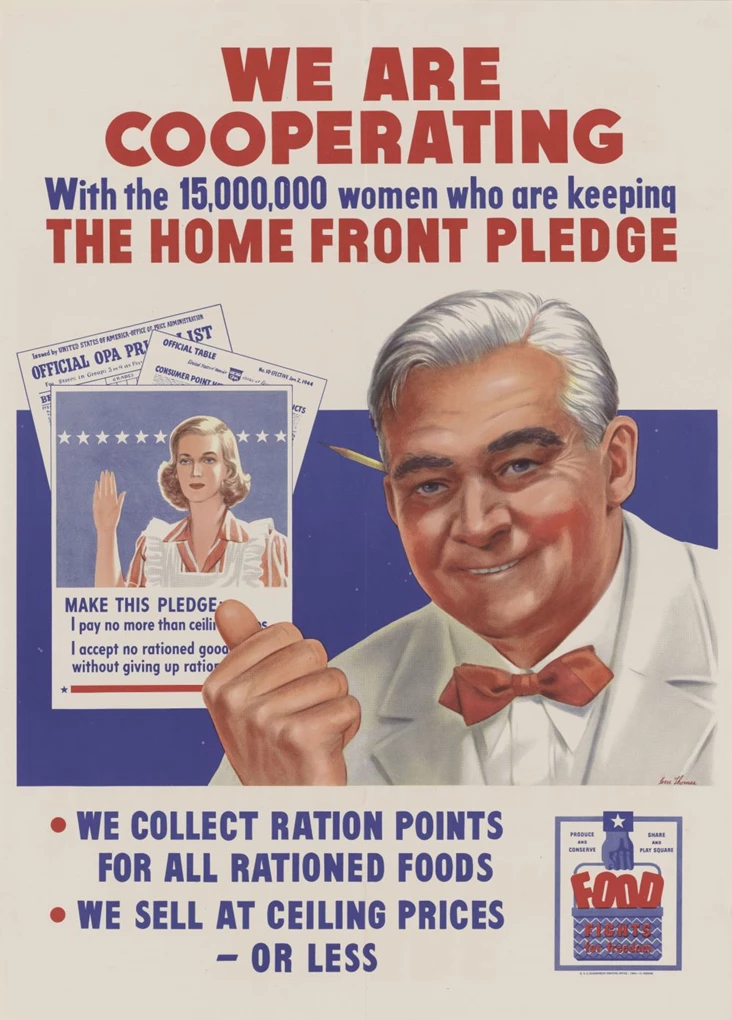
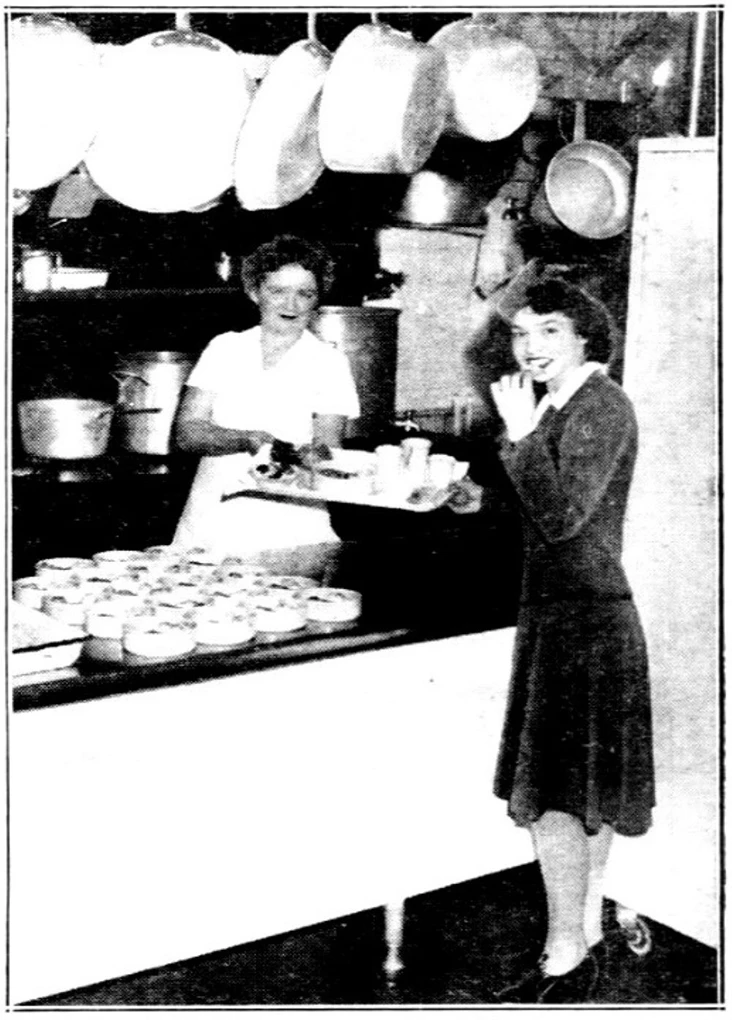
Left image
“We Are Cooperating with the 15,000,000 Women Who Are Keeping the Home Front Pledge.” Office of Price Administration, 1944.
Credit: Collection of the National Archives and Records Administration (NAID: 516060).
Right image
“Meatless fare for Tuesday airline passengers from LaGuardia Field is sampled by Goldie Astleford, hostess on the New York to Kansas City run. They don’t have meatless Tuesdays in KC.” (1943)
Credit: Sunday News (Daily News) (New York City), January 31 1943, p. 85.
Meat was on the ration list from March 1943 through November 1945.[1] Red stamps from Ration Book Two onward were used to buy meat, as well as cheese and fats (blue stamps were for processed foods – which included canned meat like corned beef). Meat was rationed by the type of meat, the cut, and by weight (but not the quality), with points assessed by the pound. Ceiling prices were also set for meats.[2]
To cut back on meat consumption, New York City Mayor LaGuardia instituted Meatless Tuesdays across the city. It caused confusion about what counted as meat -- and was very unpopular with hot dog makers, among others. Other places followed suit.[3] But Americans loved their beef – especially steaks. Many did not give them up, even though a single steak could use half a month’s worth of points. When entertaining, it was common for guests to bring their own steaks for grilling, while the host provided the rest of the meal.[4]
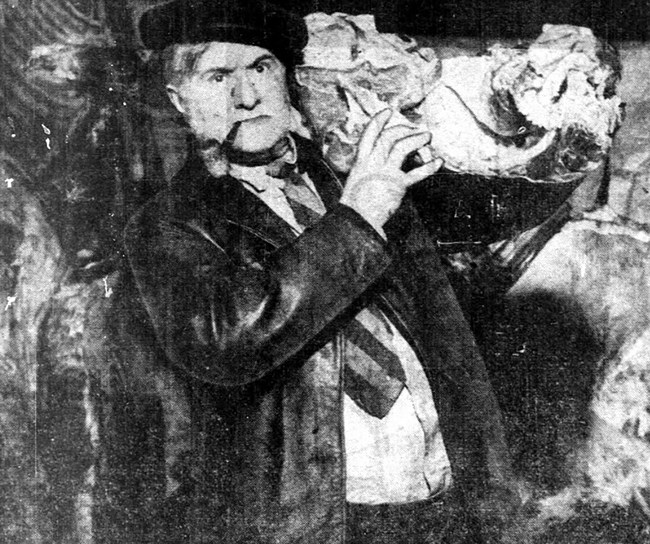
Pittsburgh Post-Gazette, April 13, 1945, p. 5.
Black Market Meat
Red meat – especially beef -- was so ingrained in American culture that it drew otherwise patriotic people to the black market.[5] To discourage this, the government promoted the “Home Front Pledge” to shopkeepers and citizens.[6] In 1944, the Office of Price Administration estimated that as much as 17% of the nation’s meat trade was via the black market. The press called it “meatlegging,” conjuring Prohibition-era bootlegging in illicit alcohol.[7]
In 1945, Pittsburgh Post-Gazette reporter Ray Sprigle posed as Alois Vondich, a black market buyer for meat. In only three weeks during his investigative reporting, he was able to buy over 2,000 pounds of meat and several pounds of butter.[8] He also secured 10,000 ration stamps for $60 (about $1,000 in 2023). These may have been stolen or some of the counterfeits entering Pittsburgh from New York City and Chicago where they were being printed.[9]
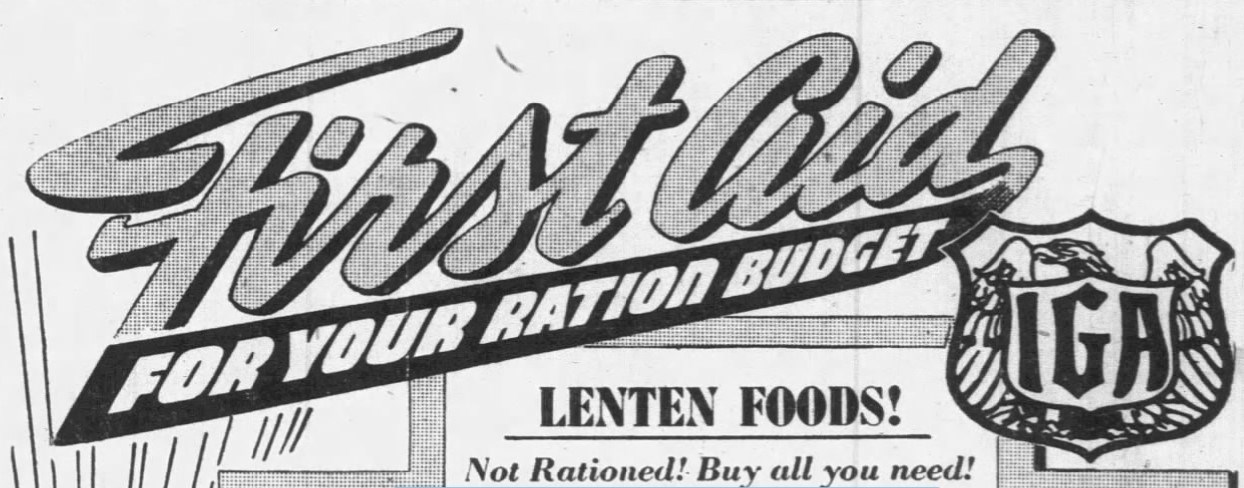
Wichita Evening Eagle, March 18, 1943, p. 10.
Alternatives
Fresh poultry and eggs were not rationed (unless canned), and Americans ate increasing amounts of chicken. Some even raised chickens in their yards. People with access to large amounts of meat (like one woman who bought a cow with friends) also preserved meat by canning it (canning meat in fats is called potting).[10]
Women's magazines and newspapers published tips and recipes about how to stretch meat. These included using small amounts to add flavor in stews, soups, and casseroles. Articles and recipes also promoted using types and cuts of meat that people were unfamiliar with or were less popular. Lamb, pork, veal, ground meats, and “variety meats” were all lower point values than cuts of beef.[11]

National Archives and Records Administration (NAID: 515961).
Recipe: Emergency Steak
1 cup flaked wheat cereal
1/3 cup milk
2 tablespoons very finely chopped onion
3/4 teaspoon salt
1/4 teaspoon ground black pepper
1 pound ground beef
Combine cereal, milk, onion, salt, and pepper in a medium bowl; set aside 5 minutes. Preheat broiler. Grease center of shallow roasting pan. Stir ground beef into cereal mixture and place on the greased roasting pan. Pat into the shape of a T-bone steak. Broil 6 inches from heat source until browned — about 5 minutes. Turn and broil on other side until cooked through — 5 to 10 minutes longer.[12]
The Story of Variety Meats
"Variety Meats." Among the biggest challenges was getting people to use different sources of meat.[13] Organ meats were not of use to the military (soldiers wouldn’t eat them), and so there was a lot available for the civilian market. In 1940, as part of the buildup to the war, the National Research Council began a study on the food habits of the American public. The goal was to understand them, so that they could be changed to support the war. Special efforts were made to reach the whole population of the US, including African Americans, Central Europeans, and Italian Americans. The study was led by anthropologist Margaret Mead and psychologist Kurt Lewin.[14]
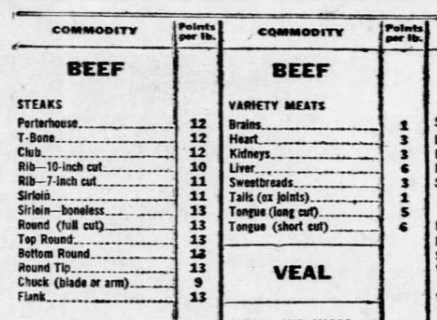
Pittsburgh Press, September 2, 1943, p. 14.
At the time, people with means considered organ meats (hearts, livers, brains, kidneys, etc.) “poor people food” and the people who ate them unsophisticated and of low social status. Patriotism would not be enough to get people to switch to organ meats. Mead and Lewin focused on why people weren’t eating organ meats. One finding was that they were not comfortable trying new things. They didn’t know what organ meats tasted like, or how to cook them. So they recommended that preparation tips and recipes be made available. And that they encourage people just to try it – once a week, say, for “variety.” The name stuck, and organ meats were marketed as “variety meats.”[15]
While not unrationed, the point values (and cost) of variety meats were significantly lower than other meat, especially premium cuts. Points for variety meats could be as low as 1 per pound.[16] Publications touted their value, communities held special cooking classes, and people swapped recipes. Slowly, the stigma of variety meats lessened. Their association shifted from “poor people’s food” to food that patriots ate. Or at least, that’s how people talked about it – complaining about them was unpatriotic.[17]

Wichita Evening Eagle, March 18, 1943, p. 10.
Recipe: Heart Loaf
Yield: 6 servings. Cooking time: 45 minutes.
The first step in preparing heart is to trim out the fibers, then wash thoroughly in cold water. Beef heart weighs three to four pounds, calf one to two pounds, port one-half to one pound, and lamb one-quarter to one-half pound. Any kind of heart can be used.
1-1/2 cups ground raw heart
1 onion
1 small carrot
1/4 cup cracker crumbs
Dash of pepper
1/2 teaspoon salt
1 egg
1/4 cup ketchup
2 tablespoons diced green pepper
Grind onion and carrot. Combine all ingredients and place in a one-pound loaf pan. Bake in a moderate oven (325F) 45-50 minutes. May be served with a tomato or brown sauce.[18]
Unlike other World War II foods, organ meats didn’t “stick” in the American diet. – except perhaps liver and onions. Part of the issue is that food habits change slowly, as a rule. When the war ended, steaks and other desirable meats became widely available again. The government didn’t help, either. All the posters and educational materials about meat rationing featured steaks, roasts, and chops, keeping them (and not organ meats) forefront.[19]
The End of Meat Rationing
For a period of seven months, from May to December 1944, most meats came off ration. There was a good supply, and only choice cuts of beef (including steak) remained rationed.[20] It didn’t last. As the Allies liberated countries overseas, the United States stepped in to help feed their citizens until they could get back on their feet. This included sending meat, and all meats were rationed again beginning December 31, 1944. Despite rationing, a severe meat shortage hit the market in the spring and summer months of 1945. Even poultry and eggs were scarce. Supply improved into the fall, and meat rationing ended on November 23, 1945.[21]
This article was written by Megan E. Springate, Assistant Research Professor, Department of Anthropology, University of Maryland, for the NPS Cultural Resources Office of Interpretation and Education. It was funded by the National Council on Public History's cooperative agreement with the National Park Service.
[1] Ames History Museum n.d.
[2] Sundin 2023.
[3] Toole 2019.
[4] Hayes 2000:101-102, 125.
[5] Hayes 2000: 101; Romm 2014; Sundin 2023; Warhawk Air Museum 2019.
[6] Hayes 2000: 101. You can read a campaign book prepared for local rationing boards for the “Home Front Pledge Campaign” via the Illinois Digital Archives.
[7] Stewart 1944: 114; Roanoke Rapids Herald 1943; Thrasher 1943.
[8] Pittsburgh Post-Gazette 1945b. Pittsburgh, Pennsylvania is an American World War II Heritage City.
[9] Pittsburgh Post-Gazette 1945c; 1945a.
[10] Hayes 2000: 56; Przybylek 2020; Sundin 2023. Potting meat is a way of preserving it in tins or jars, using fats or gelatin to seal it.
[11] Hayes 2000: 56; Przybylek 2020; Sundin 2023.
[12] Hayes 2000: 197.
[13] Romm 2014.
[14] Guthe 1943; Joffe 1943; Romm 2014. For a time, Margaret Mead lived at 75-1/2 Bedford Street in New York City. It is part of the Greenwich Village Historic District, listed on the National Register of Historic Places on June 19, 1979.
[15] Romm 2014; Wansink 2002: 90-93.
[16] Pittsburgh Press 1943.
[17] Romm 2014; Wansink 2002: 93-94.
[18] Wichita Evening Eagle, 1943. Wichita, Kansas is an American World War II Heritage City.
[19] Romm 2014.
[20] Sundin 2023.
[21] Sudnin 2023.
Ames History Museum (n.d.) “Rationed Goods in the U.S. During World War II.” Ames History Museum.
Guthe, Carl E. (1943) “History of the Committee on Food Habits.” In National Research Council, The Problem of Changing Food Habits: Report of the Committee on Food Habits 1941-1943, pp. 9-19. National Academies Press, Washington, DC.
Hayes, Joanne L. (2000) Grandma’s Wartime Kitchen: World War II and The Way We Cooked. St. Martin’s Press, New York.
Joffe, Natalie F. (1943) “Food Habits of Selected Subcultures in the United States.” In National Research Council, The Problem of Changing Food Habits: Report of the Committee on Food Habits 1941-1943, pp. 97-103. National Academies Press, Washington, DC.
Pittsburgh Post-Gazette (1945a) “Alois’ Ration Stamps – Are They Clean?” Pittsburgh Post-Gazette, April 20, 1945, p. 5.
--- (1945b) “Introducing Ray Sprigle, Black Marketer.” Pittsburgh Post-Gazette, April 13, 1945, p. 5.
--- (1945c) “Points Bought By Alois May Be Counterfeit.” Pittsburgh Post-Gazette, April 20, 1945, p. 5.
Pittsburgh Press (1943) “Red And Blue Point Changes Due Sept. 5.” Pittsburgh Press, September 2, 1943, p. 14.
Przybylek, Leslie (2020) “Bootleg Beef and Smuggled Sirloin: Black Market Meat During World War II.” Heinz History Center, April 22, 2020.
Roanoke Rapids Herald (1943) “OPA Appeal is Made to Public to Stamp Out ‘Black Markets.’” Roanoke Rapids Herald (Roanoke Rapids, NC), March 11, 1943, p. A-6. Chronicling America, Library of Congress.
Romm, Cari (2014) “The World War II Campaign to Bring Organ Meats to the Dinner Table.” The Atlantic, September 25, 2014.
Stewart, Maxwell (1944) “Anatomy of the Black Market.” In New York State Legislative Committee on Nutrition (ed.) Food – in War and in Peace. New York State Joint Legislative Committee on Nutrition, Albany, pp. 114-116.
Sundin, Sarah (2023) “Make It Do: Meat and Cheese Rationing in World War II.” Today in World War II History, March 29, 2023.
Thrasher, James (1943) “Black Markets Supply 17 Per Cent of Nation’s Meat: ‘Meatlegging’ Thrives on Greed, First Article in Series Reveals.” Daily Monitor Leader (Mount Clemens, MI), March 11, 1943, p. 7. Chronicling America, Library of Congress.
Toole, Pauline (2019) “Meatless Tuesdays.” New York City Department of Records & Information Services, November 15, 2019.
Wansink, Brian (2002) “Changing Eating Habits on the Home Front: Lost Lessons From World War II Research.” Journal of Public Policy & Marketing 21(1): 90-99.
Warhawk Air Museum (2019) “From Meatless Monday to Chef Boyardee – The Surprising Lasting Effects of Wartime Rationing.” Warhawk Air Museum, November 22, 2019.
Wichita Evening Eagle (1943) “Heart Loaf.” Wichita Evening Eagle, March 18, 1943, p 10.
Table of Contents
1. Introduction
2. The American Home Front Before World War II
3. The American Home Front and the Buildup to World War II
3B The Selective Service Act and the Arsenal of Democracy
4. The American Home Front During World War II
4A A Date That Will Live in Infamy
4A(i) Maria Ylagan Orosa
4C Incarceration and Martial Law
4D Rationing, Recycling, and Victory Gardens
4D(i) Restrictions and Rationing on the World War II Home Front
4D(ii) Food Rationing on the World War II Home Front
4D(ii)(a) Nutrition on the Home Front in World War II
4D(ii)(b) Coffee Rationing on the World War II Home Front
4D(ii)(c) Meat Rationing on the World War II Home Front
4D(ii)(d) Sugar: The First and Last Food Rationed on the World War II Home Front
4D(iii) Rationing of Non-Food Items on the World War II Home Front
4D(iv) Home Front Illicit Trade and Black Markets in World War II
4D(v) Material Drives on the World War II Home Front
4D(v)(a) Uncle Sam Needs to Borrow Your… Dog?
4D(vi) Victory Gardens on the World War II Home Front
4D(vi)(a) Canning and Food Preservation on the World War II Home Front
4E The Economy
4E(i) Currency on the World War II Home Front
4E(ii) The Servel Company in World War II & the History of Refrigeration
5. The American Home Front After World War II
5A The End of the War and Its Legacies
5A(i) Post World War II Food
More From This Series
-
 The Home Front During World War IICoffee Rationing
The Home Front During World War IICoffee RationingCoffee was rationed from November 1942 to July 1943. Each person got enough coffee to average less than one cup a day.
-
 The Home Front During World War IICanning and Food Preservation
The Home Front During World War IICanning and Food PreservationPlanting Victory Gardens was only part of the work. Efficiently and safely preserving that bounty for later use was crucial.
-
 The Home Front During World War IISugar Rationing
The Home Front During World War IISugar RationingTo make sure that the military, manufacturers, and civilians had enough sugar, it was the first food to be rationed.
Tags
- world war ii
- world war 2
- wwii
- wwii home front
- world war ii home front
- wwii homefront
- history of science
- history of food
- foodways
- government history
- military history
- kansas
- pennsylvania
- new york
- rationing
- american world war ii heritage city program
- awwiihc
- business history
- national register
- national register of historic paces
- wichita
- pittsburgh
- new york city
- chicago
- illinois
- missouri
